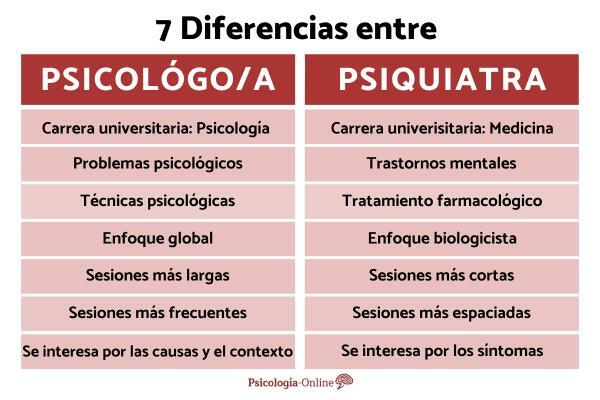
The first studies that focused on the effects that traumatic stress can have on people date back to the First World War and, in In particular, to the attention paid to the reactions of the recruited officers and soldiers, who presented states of anxiety, depressives, heart problems and fears. In fact, the conflict had not yet fully concluded that psychoanalysts, at a congress held in Budapest in September 1918, they spoke of a medical problem that had arisen when treating soldiers at the front: the neurosis of war. With this Psychology-Online article we will see in detail what is war neurosis syndrome, its symptoms, causes and possible treatments of the time.
Index
- What is war neurosis syndrome
- Causes of war neurosis
- Symptoms of war neurosis
- Freud and the war neurosis
- Treatment of war neurosis
What is the syndrome of war neurosis.
The war neurosis, also known as trench insanity, soldier's disease or soldier's syndrome, is only one of the first names by which he defined himself
Causes of war neurosis.
The horrors and atrocities of the First World War ended up causing serious damage even to the psyche of the combatants: the The global dimension of this conflict and its static nature meant that the rate of psychic problems among the troops remained constantly high. During World War I, four clinical entities were identified:
- The battle hypnosis, is characterized by the almost hypnotic state of stupor reported by the survivors of the first battles on Belgian territory.
- The howitzer or "grenade wind", refers to the soldiers thrown into the air from the explosion of the bombs or covered by the ground always after the explosion; the international psychiatric community will immediately recognize this syndrome by calling it "shell-shock".
- Anxiety due to neurasthenia.
- The war hysteria, which defines a very broad clinical picture that includes motor crises, amnesias, false blindness, mutism, tic, false anesthesia and paralysis, stuttering.
In 1918, all the pathological states described so far will be grouped under the label of "war neuroses" or, rather, "war psychoneurosis", to underline that its pathogenesis is of psychic origin. We owe this definition to the German physician Honigman, the first to coin the term "war neurosis" in 1907 (kriegsneurose), also known as trench insanity and soldier syndrome.
Symptoms of war neurosis.
How do these war neuroses manifest themselves concretely? It was suggested that the symptoms were due to the strong sensory stimulation associated with the din of the explosions, and later it became noticeable that some soldiers developed the same symptoms, without having been involved in particular incidents and explosions: under the definition of "bombing shock", therefore, the various psychiatric experiences generated by the combats were grouped, whose symptoms ranged from from the paralysis and the wander without destination until the incontinence urinary and intestinal. At the first symptoms, mutism Y apathy, we must add serious forms of anguish, amnesia, chase manias and hypersensitivity to noise (At the slightest sudden sound, many inmates assume defensive positions, as if they were in the imminence of an attack).
According to the reports of many veterans, there is the feeling of being trapped: on the one hand, death at the hands of the enemy and, on the other, in the event of an escape, death at the hands of the military court. The nightmare of a death always lurking, the deafening noise of the bombs, the blinding light of the flares and rockets provoked hallucinations, motor dysfunctions, loss of control and psychic deviations.
Therefore, the war neurosis seems to turn -analytically speaking- into a flight from an unbearable situation: it is a kind of last resort for that survival instinct buried under the repressive authority of military life.
Freud and the war neurosis.
Sigmund Freud leaves some important considerations in the introduction to the book Psychoanalysis of war neuroses and in a Memorandum on the electrical treatment of war neurotics, where he describes war neuroses as traumatic neuroses, facilitated by a pre-existing conflict in the Self. According Sigmund Freud, the father of psychoanalysis, in the traumatic state of war the ego feels a danger to itself, caused by a new I, the bellicose of the soldier, which puts him before death; and from this inner enemy he defends himself by taking refuge in a traumatic neurosis. The war forced Freud to reconsider the environmental element, the weight of external reality at the origin of psychic suffering, thus redesigning the profile of the trauma by displacing the accent on the outside world, after he had wearily brought it inside.
Treatment of war neurosis.
The sick of the First World War, accused of cowardice and treason, cruelly called "war fools", were taken to the madhouses where they were encountered psychiatrists who, in addition to not knowing how to deal with a hitherto unknown pathology, often applied rapid therapies (almost forever electroshock) with a single objective: to delay, even return, in the shortest time possible to the soldiers at the front to fight.
What to do, then, with men affected by paralysis, amnesia, tremors and other symptoms, but in the absence of organic lesions? The few physicians who followed an analytic orientation recognized in war neurosis the symptoms of an internal conflict and with the help of hypnosis they tried to cure the patients, bringing out the triggering events.
But, more than really sick, in the eyes of the specialists of the time they seemed cunning simulators, and the therapy to which they were subjected was mostly a "painful electrical treatment." Disciplinary treatment was similar in the armies of different countries and was based on administering electric shocks, screaming, isolation, food restrictions, threats... From a military point of view, the neurotic was treated as a coward who escaped his duties as a citizen. The purpose of this inhuman cure was to force the patient to abandon his illness, which had guaranteed him to stay away from the front, inducing a fear even worse than electricity; but even when the treatment was successful, once returned to the front, subjected to the fire of the enemies and the unbearable life of the trench, the patient had a relapse.
In this article we talk about the current treatment of post-traumatic stress disorder.

This article is merely informative, in Psychology-Online we do not have the power to make a diagnosis or recommend a treatment. We invite you to go to a psychologist to treat your particular case.
If you want to read more articles similar to War neurosis syndrome: what is it, symptoms, causes and treatment, we recommend that you enter our category of Clinical psychology.
Bibliography
- Castelletto, A. (2018). Gli altri feriti: the "nevrosi di war" and the vittime dimenticate of the cousin conflitto mondiale. Recovered from: https://parentesistoriche.altervista.org/nevrosi-grande-guerra/
- Crocq, L. (2012). Il trauma: story of a concept and its meaning. Psychology dell’Emergenza and dell’Assistenza Umanitaria, 9:6-21.
- Di Domenico, P. (2014). Brief history of the Prima Guerra Mondiale. Vol. 5: L'orrenda carneficina. Bologna: Area51.
- Fiocchi, C. (2014). An'esplosione di nevrosi: escape nella follia. Recovered from: https://aulalettere.scuola.zanichelli.it/come-te-lo-spiego/unesplosione-di-nevrosi-fuga-nella-follia/
- Girmenia, E. (2013). Il complesso di Abramo. Psychology of modern warfare and civil society control. Rome: Armando Editore.
- Morosi, S., Rastelli P. (2017). "Il sorriso della follia": il soldato sotto shock. Recovered from: https://pochestorie.corriere.it/2017/10/19/il-sorriso-della-follia-il-soldato-sotto-shock/
- Tagliaferro, G. (2017). I know you stesso. Elementi di psychology. Rome: Armando Editore.
War neurosis syndrome: what is it, symptoms, causes and treatment


